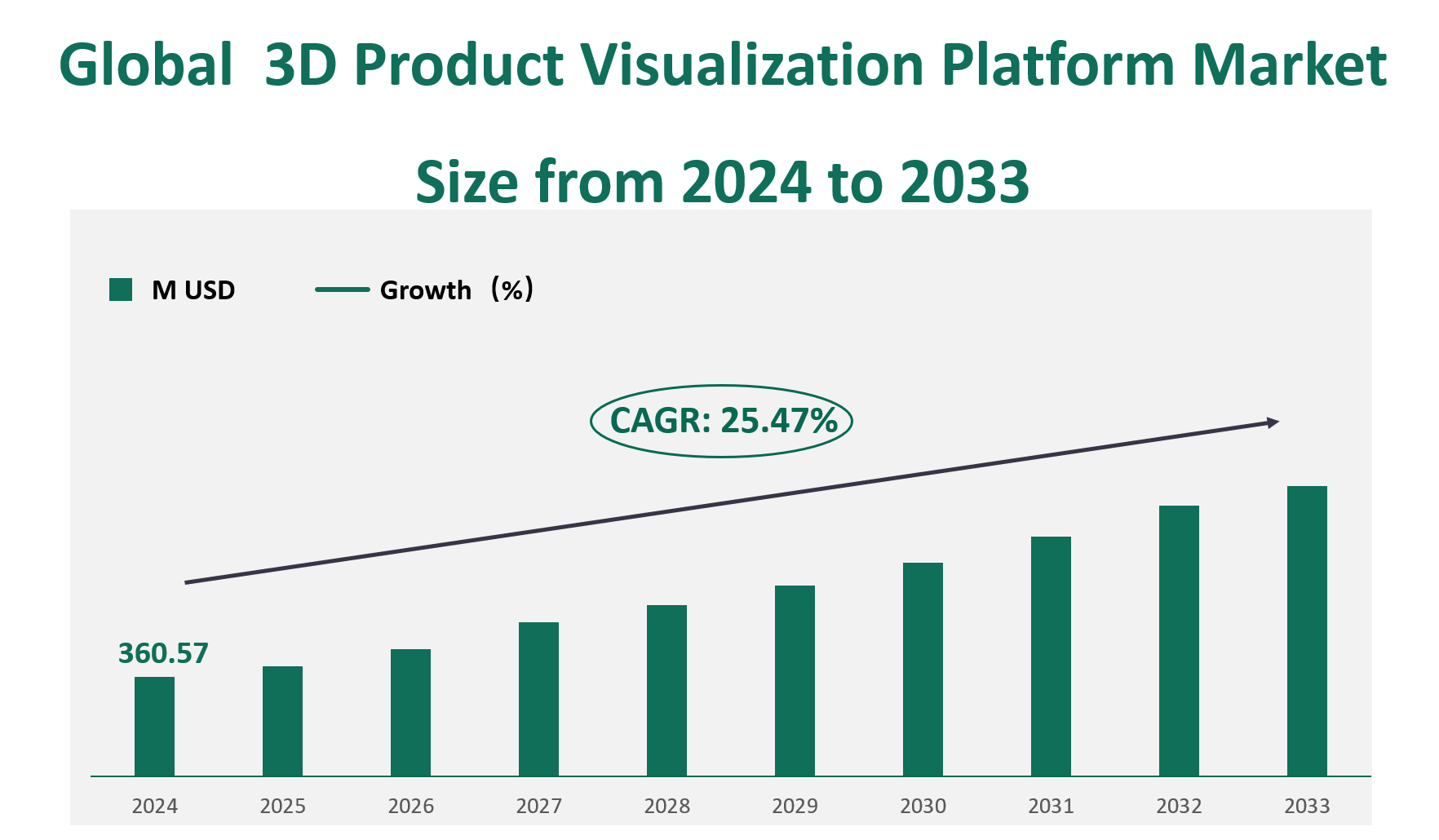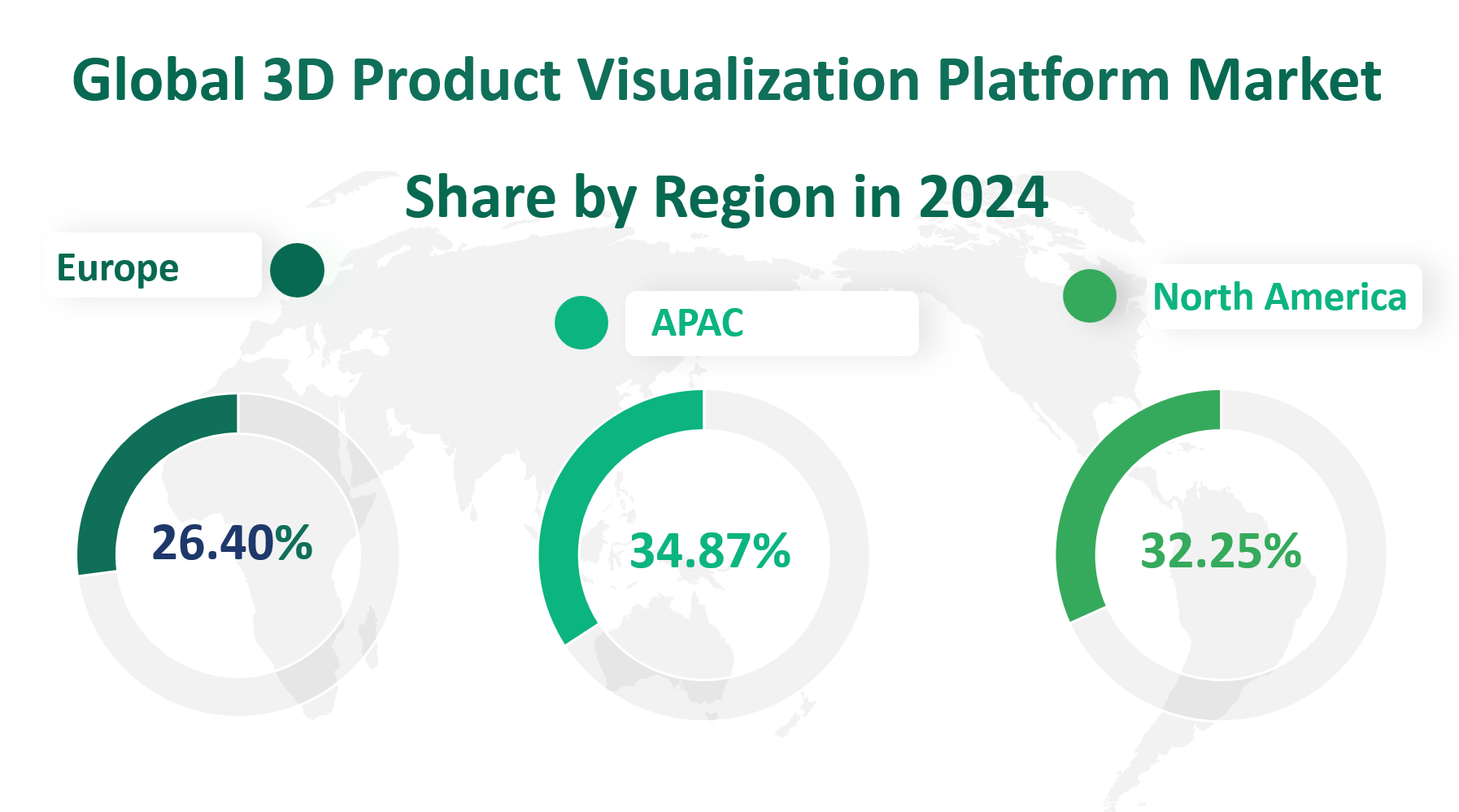1. Global 3D Product Visualization Platform Market Revenue and Future Growth
In 2024, the global 3D Product Visualization Platform market value is projected to reach $360.57 million. This growth is expected to continue at a compound annual growth rate (CAGR) of 25.47% from 2024 to 2033, reflecting the rapid adoption of 3D visualization technologies across various industries.
A 3D Product Visualization Platform is a sophisticated system that enables the creation and management of three-dimensional representations of products. These platforms provide businesses with the ability to showcase their products in a more engaging and detailed manner than traditional two-dimensional images or text descriptions. By leveraging advanced technologies such as computer-aided design (CAD), photorealistic rendering, and augmented reality (AR), these platforms allow users to interact with products in a virtual environment, providing a realistic and immersive experience.
The primary function of a 3D Product Visualization Platform is to bridge the gap between physical products and digital representations, enabling customers to visualize products in various configurations, colors, and settings. This capability is particularly valuable in industries such as furniture, automotive, fashion, and electronics, where customers often need to see how products will look in their specific environments before making a purchase decision.
Figure Global 3D Product Visualization Platform Market Size (M USD) and CAGR (2024-2033)

2. 3D Product Visualization Platform Market Growth Drivers and Restraints
The growth of the 3D Product Visualization Platform market is driven by several key factors. One of the primary drivers is the increasing adoption of e-commerce and online shopping. As more consumers turn to digital channels for their shopping needs, businesses are under pressure to enhance their online presence and provide engaging product experiences. 3D visualization platforms offer a solution by allowing customers to explore products in a more interactive and detailed manner, thereby improving their online shopping experience and increasing the likelihood of conversion.
Another significant driver is the growing demand for personalized and customized products. Consumers today are increasingly seeking unique and tailored products that cater to their specific needs and preferences. 3D visualization platforms enable businesses to offer customization options, allowing customers to configure products according to their desired specifications. This capability not only enhances customer satisfaction but also provides businesses with valuable insights into consumer preferences, helping them make better-informed product development and marketing decisions.
Furthermore, advancements in technology, such as improved computing power, graphics processing capabilities, and the widespread availability of high-speed internet, have made it more feasible and cost-effective for businesses to implement 3D visualization solutions. The integration of emerging technologies like virtual reality (VR) and augmented reality (AR) with 3D visualization platforms is also driving market growth, as these technologies offer even more immersive and interactive product experiences.
However, there are also some limiting factors that may hinder the growth of the 3D Product Visualization Platform market. One of the main challenges is the high initial investment required to develop and implement these platforms. Businesses, particularly small and medium-sized enterprises (SMEs), may face financial constraints when it comes to adopting advanced 3D visualization technologies. The costs associated with software development, hardware infrastructure, and skilled personnel can be significant, which may deter some companies from investing in these platforms.
Additionally, the complexity of integrating 3D visualization platforms with existing business systems and processes can pose challenges. Many businesses have established workflows and systems in place, and integrating a new technology like 3D visualization may require substantial changes and adjustments. This can lead to resistance from employees and potential disruptions to business operations, making it difficult for some companies to fully embrace and leverage the benefits of 3D visualization platforms.
Moreover, the lack of awareness and understanding of the capabilities and benefits of 3D visualization platforms among some businesses and consumers can also act as a limiting factor. While the technology is gaining traction, there may still be misconceptions or skepticism about its effectiveness and value. This can result in slower adoption rates and hinder the overall growth of the market.
3. 3D Product Visualization Platform Market Technology Innovation
The 3D Product Visualization Platform market is characterized by continuous technological innovation, as companies strive to enhance their offerings and stay competitive. One of the key areas of innovation is the integration of artificial intelligence (AI) and machine learning (ML) technologies into 3D visualization platforms. AI and ML can enable more advanced features, such as personalized product recommendations based on user behavior and preferences, automated design optimization, and intelligent analysis of customer interactions with 3D models. This can help businesses gain deeper insights into consumer trends and preferences, allowing them to create more targeted and effective marketing strategies.
Another significant innovation is the development of more user-friendly and accessible 3D visualization tools. Traditionally, creating and managing 3D models required specialized skills and expertise. However, advancements in technology have led to the emergence of more intuitive and easy-to-use platforms that enable businesses to create and customize 3D visualizations without extensive technical knowledge. This democratization of 3D visualization tools is making it more accessible to a wider range of businesses, including SMEs, and is driving the adoption of these platforms across various industries.
4. Analyzing the Different Types of 3D Product Visualization Platform Market
The 3D Product Visualization Platform market is primarily segmented into two product types: Cloud-Based and On-Premises.
Cloud-based 3D Product Visualization Platforms are hosted on remote servers and accessed via the internet. They offer scalable, flexible, and cost-effective solutions for businesses looking to integrate 3D visualization capabilities into their operations without the need for significant upfront investment in hardware and software infrastructure. These platforms provide a wide range of services, including 3D modeling, rendering, and interactive visualization, all accessible through a web browser. The market size for cloud-based platforms is expected to reach approximately $331.22 million in 2024.
Definition: On-premises 3D Product Visualization Platforms are installed and operated within the user’s own infrastructure, typically on local servers or workstations. These platforms offer businesses greater control over their data and operations, as well as the ability to customize and tailor the platform to their specific needs. However, they also require significant upfront investment in hardware, software, and personnel, as well as ongoing maintenance and support costs. The market size for on-premises platforms is projected to be around $29.34 million in 2024.
Table Global 3D Product Visualization Platform Market Size and Share by Type in 2024
|
Type |
Market Size (M USD) 2024 |
Market Share |
|
Cloud Based |
331.22 |
91.86% |
|
On-premises |
29.34 |
8.14% |
5. Analyzing the Different Applications of the 3D Product Visualization Platform Market
The 3D Product Visualization Platform market is utilized across various applications, with the two primary segments being Small and Medium-sized Enterprises (SMEs) and Large Enterprises.
SMEs are legally independent companies with a limited number of employees, typically ranging from 0 to 1000 employees, and an annual income between $10 million and $1 billion. These businesses often face challenges such as limited resources, budget constraints, and the need to compete with larger enterprises. 3D Product Visualization Platforms offer SMEs a cost-effective way to enhance their product presentations, improve customer engagement, and gain a competitive edge in the market.
The market size for SMEs in the 3D Product Visualization Platform market is projected to be around $132.37 million in 2024. This represents a significant opportunity for platform providers to cater to the needs of this diverse and growing segment.
Large Enterprises are organizations with a substantial number of employees, exceeding 1,000, and an annual income of over $1 billion. These enterprises often have complex operations, diverse product portfolios, and a global presence. They require robust and scalable 3D Product Visualization Platforms to streamline their product development, marketing, and sales processes, as well as to enhance customer experiences across various channels. The market size for Large Enterprises in the 3D Product Visualization Platform market is projected to be around $228.20 million in 2024.
Table Global 3D Product Visualization Platform Market Size and Share by Application in 2024
|
Application |
Market Size (M USD) 2024 |
Market Share |
|
SMEs |
132.37 |
36.71% |
|
Large Enterprises |
228.20 |
63.29% |
6. Global 3D Product Visualization Platform Market Size by Region
North America is projected to have a substantial market size for 3D Product Visualization Platforms in 2024, reaching approximately $116.28 million. This region has been at the forefront of technological advancements and digital transformation, which has fueled the adoption of 3D visualization tools. The presence of numerous tech-savvy consumers who prefer immersive shopping experiences has driven businesses to invest in 3D visualization technologies.
Europe is expected to have a market size of around $95.20 million in 2024. This region has been actively embracing digital solutions to enhance customer engagement and streamline operations. The European market benefits from a diverse range of industries, including automotive, furniture, and fashion, which have significant demands for 3D visualization.
The Asia-Pacific region is anticipated to be the fastest-growing market, with a projected size of $125.74 million in 2024. This region’s rapid economic growth and expanding consumer base have created immense opportunities for 3D Product Visualization Platforms.
Latin America is expected to have a market size of $14.14 million in 2024. While this is a smaller market compared to other regions, it is experiencing steady growth.
The Middle East & Africa region is projected to have a market size of $9.20 million in 2024. This region is gradually embracing digital technologies to enhance its business operations and customer experiences.
Figure Global 3D Product Visualization Platform Market Size by Region in 2024

7. Global 3D Product Visualization Platform Market Analysis by Major Players
7.1 Marxent
Company Introduction and Business Overview: Marxent is a global leader in 3D e-commerce solutions, specializing in furniture, kitchen, bath, outdoor, and office furniture. Founded in 2011 and headquartered in the USA, Marxent offers a comprehensive platform called 3D Cloud, which enables retailers and brands to create, manage, and publish 3D content across various applications.
Products Offered: The 3D Cloud platform includes features such as 3D workflow, content management, applications, and analytics. It allows businesses to create large catalogs of 3D products, manage systems integrations, deploy branded 3D apps, and measure app performance.
Sales Revenue in 2022: In 2022, Marxent generated a revenue of $8.46 million in the 3D Product Visualization Platform business.
7.2 Threekit
Company Introduction and Business Overview: Threekit is a 3D product configuration and visualization platform that enables brands to create and manage visuals at scale. Founded in 2005 and headquartered in the USA, Threekit offers solutions that enhance online customer engagement and conversions.
Products Offered: Threekit’s platform includes features such as component modeling, centralized management of product assets, and distribution of product assets across various channels. It also offers a Virtual Photographer program for creating photorealistic product images.
Sales Revenue in 2022: In 2022, Threekit achieved a revenue of $6.37 million in the 3D Product Visualization Platform business.
7.3 Microsoft
Company Introduction and Business Overview: Microsoft Corporation is a leading multinational technology company that produces computer software, consumer electronics, personal computers, and related services. Founded in 1975 and headquartered in the USA, Microsoft offers a wide range of products and services, including Dynamics 365 Product Visualize for 3D product visualization.
Products Offered: Dynamics 365 Product Visualize is a solution that helps businesses create shared understanding between buyers and sellers, accelerate sales processes, and build buyer confidence through 3D product visualization models.
Sales Revenue in 2022: In 2022, Microsoft generated a revenue of $7.11 million in the 3D Product Visualization Platform business.

